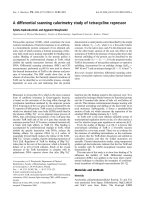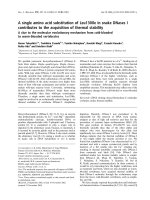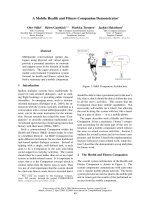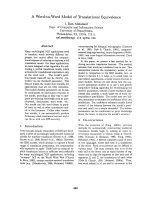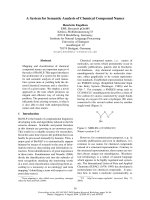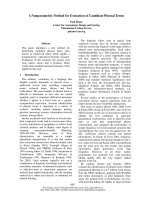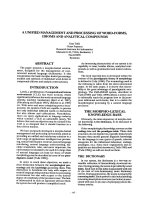báo cáo khoa học:" A pigmented calcifying cystic odontogenic tumor associated with compound odontoma: a case report and review of literature" doc
Bạn đang xem bản rút gọn của tài liệu. Xem và tải ngay bản đầy đủ của tài liệu tại đây (521.6 KB, 6 trang )
BioMed Central
Page 1 of 6
(page number not for citation purposes)
Head & Face Medicine
Open Access
Case report
A pigmented calcifying cystic odontogenic tumor associated with
compound odontoma: a case report and review of literature
Phuu P Han
1
, Hitoshi Nagatsuka*
1
, Chong H Siar
2
, Hidetsugu Tsujigiwa
1
,
Mehmet Gunduz
1
, Ryo Tamamura
1
, Silvia S Borkosky
1
, Naoki Katase
1
and
Noriyuki Nagai
1
Address:
1
Department of Oral Pathology and Medicine, Graduate School of Medicine, Dentistry and Pharmaceutical Sciences, Okayama
University, Okayama 700-8525, Japan and
2
Department of Oral Pathology, Oral Medicine and Periodontology, Faculty of Dentistry, University of
Malaya, 50603 Kuala Lumpur, Malaysia
Email: Phuu P Han - ; Hitoshi Nagatsuka* - ; Chong H Siar - ;
Hidetsugu Tsujigiwa - ; Mehmet Gunduz - ;
Ryo Tamamura - ; Silvia S Borkosky - ;
Naoki Katase - ; Noriyuki Nagai -
* Corresponding author
Abstract
Background: Pigmented intraosseous odontogenic lesions are rare with only 47 reported cases
in the English literature. Among them, pigmented calcifying cystic odontogenic tumor, formerly
known as calcifying odontogenic cyst, is the most common lesion with 20 reported cases.
Methods: A case of pigmented calcifying cystic odontogenic tumor associated with odontoma
occurring at the mandibular canine-premolar region of a young Japanese boy is presented with
radiographic, and histological findings. Special staining, electron microscopic study and
immunohistochemical staining were also done to characterize the pigmentation.
Results: The pigments in the lesion were confirmed to be melanin by Masson-Fontana staining and
by transmission electron microscopy. The presence of dendritic melanocytes within the lesion was
also demonstrated by S-100 immunostaining.
Conclusion: The present case report of pigmented calcifying cystic odontogenic tumor associated
with odontoma features a comprehensive study on melanin and melanocytes, including
histochemical, immunohistochemical and transmission electron microscopic findings.
Background
Pigmented odontogenic lesions are rare, with only 47
cases reported in English literature since 1961 [Table 1].
Most of these pigmented lesions were found in racially
pigmented patients. This is a case report of a pigmented
calcifying cystic odontogenic tumor (CCOT) with special,
ultrastructural and immunohistochemical findings
together with a brief review of the English literature on
pigmented odontogenic lesions especially pigmented
CCOT.
Case presentation
A 15-year-old Japanese boy was referred to the Okayama
University Hospital by the orthodontist for management
Published: 25 September 2007
Head & Face Medicine 2007, 3:35 doi:10.1186/1746-160X-3-35
Received: 9 November 2006
Accepted: 25 September 2007
This article is available from: />© 2007 Han et al; licensee BioMed Central Ltd.
This is an Open Access article distributed under the terms of the Creative Commons Attribution License ( />),
which permits unrestricted use, distribution, and reproduction in any medium, provided the original work is properly cited.
Head & Face Medicine 2007, 3:35 />Page 2 of 6
(page number not for citation purposes)
of a mixed radiolucent and radiopaque lesion in the left
mandibular canine-premolar region detected during rou-
tine radiographic examination. The lesion was asympto-
matic and the patient's medical and family histories were
non-contributory.
On intraoral examination, there was no bony expansion
and the overlying mucosa was also normal. Panoramic
radiograph showed a well-defined unilocular radiolucent
lesion with distinct sclerotic margin containing radio-
paque masses [Fig. 1] and CT scan revealed that the lesion
was lingual to the left mandibular canine. The lesion was
small and the radiodensities of the included masses were
comparable to that of the adjacent teeth. An initial diag-
nosis of odontoma was made, and surgical excision was
performed under local anesthesia. Follicle-like tissue
encapsulating three pieces of small calcified masses, was
obtained from the surgical procedure.
Microscopic examination of the soft tissues revealed den-
tal follicle-like loose connective tissue lined by a non-
keratinized stratified epithelium of uneven thickness. The
thickest portion of the epithelium showed basal cuboidal
ameloblast-like cells and suprabasal stellate-like cells [Fig.
2]. Few round or drop-like calcifications were also
observed focally within the epithelial lining.
Among the three calcified masses, two were small orga-
noid denticles composed of enamel matrix, well-devel-
oped tubular dentin and pulp-like tissues with
intervening loose connective tissues [Fig. 2, inset]. Ghost
cells characterized by pale staining and ballooning cyto-
plasms and shadowy nuclei were seen within the odon-
togenic epithelium lining the enamel surface of the
denticles as well as within calcified matrix. The other
decalcified mass was an aggregate of ghost cells showing
various degrees of dystrophic calcification. Focal and dif-
fuse dark brown pigmentations, judged to be melanin
granules, were recognized within the epithelial cells, con-
nective tissue surrounding the denticles and also in the
cytoplasms of ghost cells undergoing dystrophic calcifica-
tion.
The melanin granules were confirmed by Masson-Fontana
staining [Fig. 3] and melanosomes were detected by trans-
Panoramic radiograph demonstrated a well-defined radiolu-cent lesion with sclerotic border in left mandibular canine region (white arrowhead)Figure 1
Panoramic radiograph demonstrated a well-defined radiolu-
cent lesion with sclerotic border in left mandibular canine
region (white arrowhead). Small, radio-opaque masses with
comparable radio densities to that of the surrounding teeth
were seen inside the radiolucent lesion.
Table 1: Reported cases of pigmented intraosseous odontogenic
lesions
2–8, modified)
Diagnosis No. of cases Race of the patient
Calcifying cystic
odontogenic tumor
20 7 Japanese
3 Black
2 Indian*
one patient from 5
1 White
1 Chinese*
5
1 Malay*
5
1 West Indian
1 Hispanic
3 ND
Keratocystic
odontogenic tumor
85 Japanese
(Odontogenic
Keratocyst)
1 Black, USA
1 White
1 West Indian
Adenomatoid
odontogenic tumor
31 Japanese
1 Black
1 Mixed (White & Indian)
Ameloblastic fibro-
odontoma
33 Japanese
Odontoma
(Complex)
22 Japanese
Odonto-
ameloblastoma
1 Japanese
Ameloblastic fibroma 1 Black
Odontogenic fibroma 1 ND
Ameloblastic
fibrodentinoma
1 Japanese
Unclassified Tumor
(?CEOT)
1 Black
Malignant
ameloblastoma
1 Japanese*
6
Ameloblastic
carcinoma
1White*
7
Primary intraosseous
carcinoma
1 Japanese*
8
Dentigerous cyst 1 Japanese
Lateral periodontal
cyst
1 Black, Israel
Botryoid odontogenic
cyst
1 Black, South Africa
Total 47 cases
* Additional cases found in the literature, ND Not described,
Modified from the previous review due to the overlapping of a case
Head & Face Medicine 2007, 3:35 />Page 3 of 6
(page number not for citation purposes)
mission electron microscopy (TEM) [Fig. 4, Fig. 5]. S-100
immunostaining revealed the presence of dendritic
melanocytes within the ghost cell aggregates [Fig. 6].
Discussion
A final diagnosis of pigmented CCOT associated with
compound odontoma was undertaken due to the pres-
ence of well-developed denticles within the small cystic
structure lined by typical odontogenic epithelium based
on the criteria for the diagnosis of CCOT by the World
Health Organization [1]. Reviews on pigmented odon-
togenic lesions [2-4] together with case reports from our
literature search [5-8], revealed 47 cases. All these
reported cases are summarized in Table I in order of abun-
dance. The most commonly recognized pigmented odon-
togenic lesion is calcifying odontogenic cyst (COC),
recently renamed as CCOT [1] with 20 reported cases
[Table 2].
Among those pigmented CCOTs, 5 were associated with
odontomas, 2 compound type and 3 complex or compos-
ite odontomas. All cases were intraosseous lesions and 10
out of 20 cases included special staining for melanin but
only one with TEM examination. The present case report
of pigmented CCOT associated with odontoma (CCO-
TaO) features a comprehensive study on melanin and
melanocytes with special and immunohistochemical
staining together with identification of melanosomes by
TEM.
The exact etiology of melanin pigmentation in intraos-
seous odontogenic lesions is unknown, leaving room for
speculation. As described in previous reports, most of the
patients were Blacks and Asians, thereby implicating racial
pigmentation to be an important factor [2,4]. Melano-
cytes, normally present in the oral mucosa, are also found
in the dental lamina or tooth bud of the fetuses more
commonly in pigmented race [9]. Odontogenesis is a
complex process resulting from the reciprocal and close
interactions between oral epithelium and cranial neural
crest-derived ectomesenchyme [10]. It might not be sur-
prising that melanocytes, which are also of neural crest in
origin, may be present in dental lamina and odontogenic
lesions. Another possibility is that a few proportion of
lesional odontogenic tissue could have potential for neu-
roectodermal differentiation under certain circumstances.
It is also rational to speculate that the quantity of melano-
cytes and the conditions or predisposing factors activating
The epithelial lining (at the thickest portion) showed basal palisaded cuboidal cells and suprabasal stellate cellsFigure 2
The epithelial lining (at the thickest portion) showed basal palisaded cuboidal cells and suprabasal stellate cells. Small focal calci-
fications within the epithelium can also be observed. (H&E, 20×). One of the small organoid denticles is shown in the inset.
Head & Face Medicine 2007, 3:35 />Page 4 of 6
(page number not for citation purposes)
them for melanin production might be associated with
racial pigmentation. Further studies are necessary to prove
or refute these possibilities.
Although the 2005 WHO classification includes CCOT as
a benign odontogenic neoplasm [1], CCOT features heter-
ogenous histologic spectrum ranging from cystic to solid
structure, and exhibits a variety of clinico-pathologic and
behavioral characters [11,12]. Because of the diverse clin-
ico-histologic features and the various neoplastic poten-
tial, there have been disagreements on the terminology as
well as whether to classify CCOTs as a cyst or a neoplasm.
Moreover, CCOT is frequently associated with other
lesions such as odontoma, ameloblastoma and amelob-
lastic fibroma, and the most common of these is the CCO-
TaO [11,12]. The prevalence of CCOTaO was reported in
17.4% of 92 cases by Hong [11], 23.8% of 21 cases by Li
TJ [12] and 35% of 215 cases by Buchner [13]. A concen-
sus still lacks on the classification of CCOTaO either as a
The presence of S-100 positive cells with cellular processes within the ghost cells aggregates (S100 immunostaining with AEC chromogen, 40×)Figure 6
The presence of S-100 positive cells with cellular processes
within the ghost cells aggregates (S100 immunostaining with
AEC chromogen, 40×).
Transmission electron micrograph of the cyst lining epithe-liumFigure 4
Transmission electron micrograph of the cyst lining epithe-
lium. Melanosomes were seen within the epithelial cells. A
pseudoglandular space lined by basement membrane was
marked by asterisk (4,200×).
Odontogenic epithelium and ghost cells stained with Masson-Fontana for melanin pigmentationFigure 3
Odontogenic epithelium and ghost cells stained with Masson-
Fontana for melanin pigmentation. Melanin pigments were
detected within the epithelial cells, in the ghost cells and also
lying freely within the extracellular connective tissue. (Mas-
son Fontana, 40×).
Irregular melanosomes with some inclusions could be observed with higher magnification under transmission elec-tron microscope (24,000×)Figure 5
Irregular melanosomes with some inclusions could be
observed with higher magnification under transmission elec-
tron microscope (24,000×).
Head & Face Medicine 2007, 3:35 />Page 5 of 6
(page number not for citation purposes)
separate type of CCOT, i.e., combined odontogenic lesion
with some proliferative potential [14,15] or as a sub-type
of non-proliferative simple unicystic type of CCOT. Hirsh-
berg analyzed 52 cases of CCOTaO and proposed CCO-
TaO to be regarded as a separate entity and suggested the
term "odontocalcifying odontogenic cyst", due to the
unique histologic features and its female predilection with
the predominant distribution pattern to the maxilla [14].
However, it is generally accepted that CCOTaO occurs in
a significantly younger age group compared to other types
[11,14,17].
Pigmented compound odontoma was considered as a dif-
ferential diagnosis because of the presence of ghost cells
with subsequent calcification and that the occurrence of
odontogenic epithelium is not rare in odontomas [18-
20]. Combination lesions should also be anticipated
because the odontogenic epithelium in different areas
might undergo variable degrees of differentiation and
degeneration [21]. In reality, the differentiation of CCO-
TaO from odontoma is difficult and subjective for some
cases. There seems to be a mere difference in clinical
behavior and growth potential between these two lesions
and the controversy is merely of academic interest. The
treatment for both lesions is conservative enucleation and
the recurrence is very rare.
Conclusion
This is a case of pigmented CCOTaO with comprehensive
studies on melanin pigments that will add to the rare lit-
erature of pigmented odontogenic lesions. All the
reported cases of pigmented intraosseous odontogenic
lesions in the English literature since 1961, especially pig-
mented CCOT, were reviewed and summarized for aca-
demic purpose.
Abbreviations
Calcifying cystic odontogenic tumor (CCOT), Calcifying
cystic odontogenic tumor associated with odontoma
(CCOTaO), Calcifying odontgenic cyst (COC)
Competing interests
The author(s) declare that they have no competing inter-
ests.
Authors' contributions
PPH, HN, CHS carried out the case study, discussed and
reviewed the literature and prepared the manuscript. MG,
RT and NN participated in the discussion and review proc-
ess and also in critical revision of the manuscript. SB and
KN helped in data collection and reviewing of the litera-
ture. All the authors have read and approved the manu-
script.
Table 2: Reported cases of pigmented calcifying odontogenic cyst in the literature
2, modified)
Author and Year Age Sex Site Race/Nationality Odontoma
Lurie HI(1961)* 23 F Max Bantu Complex
Gorlin et al.(1964)* 16 M Max Unknown
Duckworth &
Seward(1965)
24 F Max Negro
Abrams &
Howell(1968)*
21 F Max Caucasian
Chandi &
Simon(1970)*
27 M Man From India
Sauk(1972) 64 M Man Unknown
Petri and
Stump(1976)*
11 F Max Negro
Saito et al.(1982) 13 M Man Japanese
9 F Man Japanese Compound
35 F Max Japanese
Nagao et al.(1982) 13 F Man Japanese Complex
Somes(1982)* 15 F Man West Indian
Schwimmer et
al.(1983)
13 M Man Hispanic
Takeda et al.(1985b)* 21 M Max Japanese
Keszler &
Guglielmotti(1987)
15 F Max Unknown Composite
Siar & Ng (1987)* 16 F Max Chinese Compound
31 M Max Indian
68 F Man Malay
Takeda et al.(1990) 17 M Man Japanese
11 F Man Japanese
* Studies with special staining to melanin pigmentation.
Publish with Bio Med Central and every
scientist can read your work free of charge
"BioMed Central will be the most significant development for
disseminating the results of biomedical research in our lifetime."
Sir Paul Nurse, Cancer Research UK
Your research papers will be:
available free of charge to the entire biomedical community
peer reviewed and published immediately upon acceptance
cited in PubMed and archived on PubMed Central
yours — you keep the copyright
Submit your manuscript here:
/>BioMedcentral
Head & Face Medicine 2007, 3:35 />Page 6 of 6
(page number not for citation purposes)
Acknowledgements
This work was supported by Grants-in-Aid for Scientific Research (B)
No.17406027 and (C) No.19592109 from the Japanese Ministry of Educa-
tion, Culture, Sports, Science and Technology. Written consent for publi-
cation was obtained from the patient or their relative.
The authors would like to thank Ms. Yoshiko Kurashige and Mr. Tadao
Zoda for their expert technical assistances in histological and electron
microscopic preparations and Dr. Rosario Santos Rivera for her great help
in manuscript editing.
References
1. Barnes L, Eveson JW, Reichart P, Sidransky D, (Eds.): World Health
Organization Classification of Tumors. Pathology and
Genetics of Head and Neck Tumors. IARC Press: Lyon;
2005:283-327.
2. Buchner A, David R, Carpenter W, Leider A: Pigmented lateral
periodontal cyst and other pigmented odontogenic lesions.
Oral Dis 1996, 2:299-302.
3. Takeda Y, Sato H, Satoh M, Nakamura S, Yamamoto H: Pigmented
ameloblastic fibrodentinoma: a novel melanin-pigmented
intraosseous odontogenic lesion. Virchows Arch 2000,
437:454-458.
4. Takeda Y, Yamamoto H: Case report of a pigmented dentiger-
ous cyst and a review of the literature on pigmented odon-
togenic cysts. J Oral Sci 2000, 42:43-46.
5. Siar CH, Ng KH: Melanin Pigment in Calcifying Odontogenic
Cysts. Singapore Dent J 1987, 12:39-42.
6. Takeda Y: Melanocytes in malignant ameloblastoma. Pathol Int
1996, 46:777-781.
7. Üzüm N, Akyol G, Asal K, Köybas¸ioğlu A: Ameloblastic carci-
noma containing melanocyte and melanin pigment in the
mandible: a case report and review of the literature. J Oral
Pathol Med 2005, 34:618-620.
8. Ijiri R, Onuma K, Ikeda M, Kato K, Toyoda Y, Nagashima Y, Ito Y,
Abiko Y, Tanaka Y: Pigmented intraosseous odontogenic carci-
noma of the maxilla: a pediatric case report and differential
diagnosis. Hum Pathol 2001, 32:880-884.
9. Lawson W, Abaci IF, Zak FG: Studies on melanocytes. V: The
presence of melanocytes in the human dental promordium:
an explanation for pigmented lesions of the jaws. Oral Surg
Oral Med Oral Pathol 1976, 42:375-380.
10. Sharpe PT: Neural crest and tooth morphogenesis. Adv Dent
Res 2001, 15:4-7.
11. Hong SP, Ellis GL, Hartman KS: Calcifying odontogenic cyst. A
review of ninety-two cases with reevaluation of their nature
as cysts or neoplasms, the nature of ghost cells and subclas-
sification. Oral Surg Oral Med Oral Pathol 1991, 72:56-64.
12. Li TJ, Yu SF: Clinicopathologic spectrum of the so-called calci-
fying odontogenic cysts: a study of 21 intraosseous cases with
reconsideration of the terminology and classification. Am J
Surg Pathol 2003, 27:372-384.
13. Buchner A: The central (intraosseous) calcifying odontogenic
cyst: an analysis of 215 cases. J Oral Maxillofac Surg 1991,
49:330-339.
14. Hirshberg A, Kaplan I, Buchner A: Calcifying odontogenic cyst
associated with odontoma: a possible separate entity (odon-
tocalcifying odontogenic cyst). J Oral Maxillofac Surg 1994,
52:555-558.
15. Takata T, Lu Y, Ogawa I, Zhao M, Zhou ZY, Mock D, Nikai H: Pro-
liferative activity of calcifying odontogenic cysts as evaluated
by proliferating cell nuclear antigen labeling index. Pathol Int
1998, 48:877-881.
16. Toida M: Proliferative activity and subtyping of calcifying
odontogenic cyst. Pathol Int 2000, 50:81-83.
17. Praetorius F, Hjorting-Hansen E, Gorlin RJ, Vickers RA: Calcifying
odontogenic cyst. Range, variations and neoplastic potential.
Acta Odontol Scand 1981, 39(4):227-240.
18. Miki Y, Oda Y, Iwaya N, Hirota M, Yamada N, Aisaki K, Sato J, Ishii T,
Iwanari S, Miyake M, Kudo I, Komiyama K: Clinicopathological
studies of odontoma in 47 patients. J Oral Sci 1999,
41(4):173-176.
19. Chang JY, Wang JT, Wang YP, Liu BY, Sun A, Chiang CP: Odon-
toma: a clinicopathologic study of 81 cases. J Formos Med Assoc
2003, 102:876-882.
20. Kerebel B, Kerebel LM: Ghost cells in complex odontoma: A
light microscopic and SEM study. Oral Surg Oral Med Oral Path
1985, 59:371-378.
21. Abrams AM, Howell FV: The calcifying odontogenic cyst; report
of four cases. Oral Surg Oral Med Oral Pathol 1968, 25:594-606.
